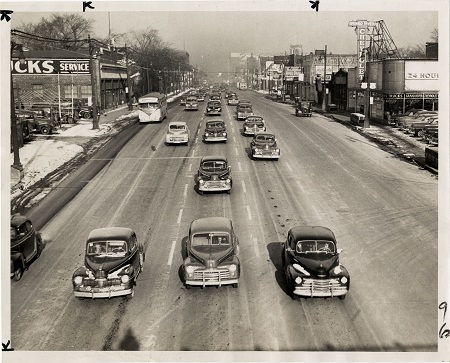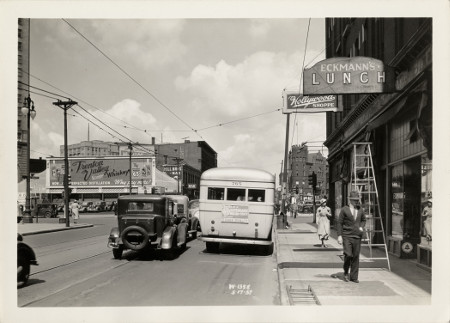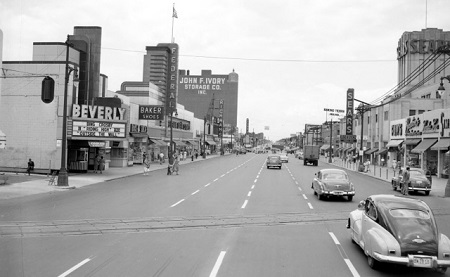By Robert Tate, Automotive Historian and Researcher
Images from the National Automotive Heritage Collection at the Detroit Public Library and DetroitTransitHistory.info
Posted: 02.13.2018

When historians, past residents and current Detroiters look back at the city's great history, Grand River Avenue is often a topic of discussion. In addition, many automotive historians have noted its importance relative to traffic management innovations, as well as the many car dealerships and gas stations that located along its diagonal route into downtown Detroit.
Grand River Avenue was officially opened with great fanfare on April 21, 1908. Many State of Michigan and Wayne County officials attended the celebration, including the following: John S. Haggerty, then Chairman, Wayne County Road Commission and later Michigan Secretary of State; William Murdock, Wayne County Road Commissioner; Milton Oakman, Wayne County Auditor; Hawley Christian, the previous Wayne County Auditor; George Dingeman; and Humphrey Brown among many others.
Over the years, Grand River Avenue was expanded further northwest and widened to accommodate additional traffic. For example, in 1930, plans to widen Grand River from Six Mile Road through what formerly had been the village of Redford (but was now part of Detroit) were advanced by Wayne County Road Commissioner Edward N. Hines.
In 1933, it was determined that Grand River and Woodward Avenue were the longest streets in Detroit. Hines noted that “Grand River Avenue, the longest street in the city, measures about 15 ½ miles from Woodward Avenue to the city limits at Seven Mile Road. Gratiot Avenue is nine miles long, and Michigan Avenue 5 ½ miles long.”
By 1947, traffic rules changed to include reversible lanes that were being used on Grand River. Four lanes were used for inbound traffic from 7 to 9 a.m. and outbound lanes from 4:30 to 6:30 p.m. Signs were posted on overhead Detroit Street Railway span wires to inform motorists of the four-lane system.
Four years later in 1951, city and state officials agreed to plans to remove two major traffic problems for motorists on Grand River and Woodward Avenue. The program called for grade separation on Grand River at the Detroit Terminal Railroad crossing below Oakman and at Woodward and Eight Mile Road. In short, overpasses were the only solution to help move traffic forward. In a letter to Detroit Mayor Cobo, State Highway Commissioner Mr. Charles M. Ziegler said the work should start at the earliest possible time. Ziegler also approved a long-term program, which provided grade separations at six other major Grand River intersections.
Finally, how Detroit became the Automobile Capital of the United States is an amazing story. The innovations on traffic control, the first gas stations and the array of automotive dealerships were all a part of the development of Detroit's Grand River Avenue.



